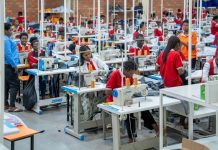Africa-Press – Rwanda. The Government has launched a Rwf49 billion five-year youth sector strategic plan (2024–2029) aimed at transforming the lives of young people through job creation, entrepreneurship, skills development, and improved access to finance and health services.
Spearheaded by the Ministry of Youth and Arts (MoYA), the plan provides a comprehensive framework to implement the National Youth Policy, with targeted interventions designed to reduce youth unemployment, support start-ups, and empower youth in key economic sectors including agriculture, ICT, and the creative industry.
Halving youth unemployment
One of the plan’s key targets is to reduce youth unemployment from 20.8 percent to 10.85 percent by 2029. It also aims to lower the proportion of young people who are not in education, employment, or training (NEET) from 32.9 percent to 20.4 percent.
To support this goal, the plan will facilitate the creation of 200 new youth jobs annually and double youth-owned businesses accessing finance from 16 percent to 32 percent. The number of youth receiving coaching, mentorship, internships, and apprenticeship training will increase by 5 percent each year.
John Bosco Kalisa, the vice chair of the Council of Small and Medium Enterprises of Rwanda (CSMER), said that such a strategic plan should consider key sectors that can create a number of jobs for youth.
“A number of sectors have the potential to create more jobs for the youth. The key ones include the creative industry such as cultural arts, music, sports activities, and digital-related activities, tourism and travel-related services, and agriculture, especially the horticulture sector. These are the main drivers of job creation,” he noted.
However, he said, the youth should possess the right skills, knowledge, and capabilities.
“We could also add light manufacturing, such as leather and leather-related products, textiles and apparel, as well as construction-related activities,” he added.
Expanding access to vocational training
The plan also sets ambitious targets for Technical and Vocational Education and Training (TVET). The employability rate of TVET graduates is expected to rise from 62 percent to 72 percent, and the share of students enrolled in TVET programmes will grow from 43 percent to 60 percent.
More than 15,500 youth will be trained in vocational courses, up from 10,688.
Reducing HIV, teenage pregnancy, and poverty
Under the Youth Health and Well-being pillar, the plan targets a reduction in HIV prevalence among youth from 2.4 percent to 0.6 percent. Teenage pregnancy will also be halved, from 5 percent to 2.5 percent.
Additionally, the proportion of young people living below the poverty line is expected to fall from 29.6 percent to 20 percent.
Boosting digital skills and jobs
With a focus on the digital economy, the plan aims to raise youth digital literacy from 13.1 percent to 63 percent and create 1,500 digital jobs by 2029.
Youth in Agriculture and Green Economy
The plan seeks to increase youth participation in agriculture particularly in high-value export crops like horticulture by scaling up training and access to resources.
Expected outcomes include increasing youth employment in export crop farming from 18.7 percent to 32 percent and doubling the share of youth using climate-resilient seed varieties.
Around 5,250 young veterinary technicians will be trained in bovine artificial insemination, and 12,000 youth will be equipped with digital skills related to animal resource management.
Additionally, 228 small green projects will be supported, and 4,800 youth will be trained in climate change adaptation. More than 1,300 young people will gain skills in green ecosystem practices.
Creative sector and sports
To harness youth talent in the arts and culture, the plan aims to create creative jobs accounting for 5 percent of the workforce, contributing 2 percent to national GDP.
At least 812 talented youth will be identified and supported to develop sustainable careers in the creative sector, and 250 more will undergo creative capacity training.
Four new Centres of Excellence for youth creative education will be established—one in each province and the City of Kigali—adding to the existing centre in Nyundo.
In sports, infrastructure at youth centres will expand by 15 percent, and 250 talented youth athletes will be supported to secure professional contracts.
Civic engagement and YouthConnekt
The number of youth participating in YouthConnekt events is expected to grow from 36,892 to over 51,000, while the number of youth volunteers involved in community development will increase to over 1.67 million.
Gender and decision-making
The plan also seeks to increase the representation of young women in decision-making bodies to 35 percent and reduce the rate of youth experiencing physical violence from 31.2 percent to 10 percent.
Yvette Nyiratebuka, a young farmer from Kayonza, called for more support for school dropouts and young farmers in rural areas.
“Many of us are engaged in small-scale agriculture. With support in TVET and financial assistance, we can grow our businesses,” she said.
Youth investment Facility and entrepreneurship Support
A cornerstone of the strategy is the creation of the Youth Investment Facility (YIF), which will be rolled out in partnership with financial institutions and fintech firms.
The facility will provide low-interest loans, reduced collateral requirements, and tailored financial products for young entrepreneurs.
Peter Clever Nsanzumuhire, a young entrepreneur making wine from coffee, emphasised the need to support youth-led startups seeking product certification like the S-Mark to improve market access.
“Access to finance is helpful, but coaching and support to meet quality standards is equally important,” he said.
The plan will also train 110,974 youth in entrepreneurship, up from 75,796.
Youth employment across economic sectors
The share of employed youth will rise in several key sectors: from 5.6 percent to 6.8 percent in industry, from 5.5 percent to 7 percent in manufacturing, and from 41 percent to 51 percent in services.
Implementation and financing
The strategic plan will require Rwf49 billion for full implementation. The budget is allocated as follows: Rwf8 billion in the first year, Rwf8.8 billion in the second, Rwf9.8 billion in the third, Rwf10.7 billion in the fourth, and Rwf11.6 billion in the final year.
For More News And Analysis About Rwanda Follow Africa-Press






